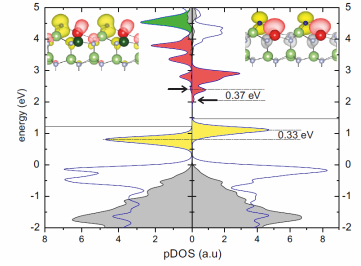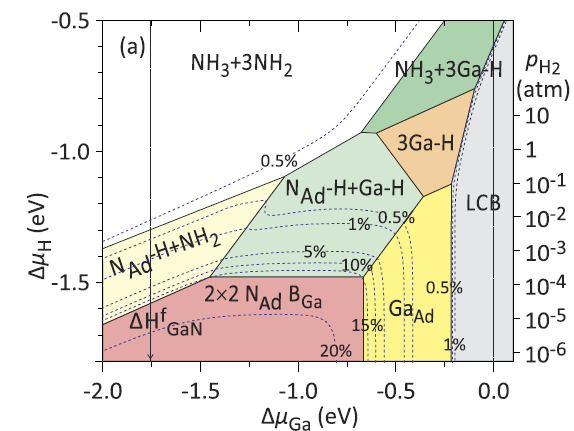Effects of surface hybridization on epitaxially grown alloys
The effect of surfaces and more specifically of surface reconstruction and rehybridization on the properties, composition, ordering and thermal stability of epitxailly grown alloys is investigated.
Surfaces play a dominant role in determining the properties of epitaxially grown materials. They break the bulk translational symmetry, provide different chemical environment, coordination and rehybridization than bulk, and allow for more efficient strain relaxation. Therefore, surface effects may alter the chemical composition and provide routes to surface engineer growth in order to obtain materials with targeted properties.
III-Nitride alloys such as InN, GaN, and AlN dominate the optoelectronics industry with applications in light emitting devices (LED), laser diodes (LD), and power electronics. Nevertheless, a major challenge that still prevents these materials to exploit their full potential is the so-called “green-gap”, i.e. the dramatic drop in efficiency when going from the blue to the green region of the optical spectrum, which corresponds to In contents in the order of ≈25-30%.
An interesting route to overcome these issues is the growth of (multiple) single monolayer InGaN layers as active region. In the present project we address this approach and we combine ab initio simulations with advanced experimental characterization techniques (molecular beam epitaxy, MBE, high resolution transmission electron microscopy, HRTEM, IKZ).

Our investigations show that the N rich growth of the optically active InGaN films is self‐limited with respect to thickness and chemical composition. Our calculations revealed that the origin of the self-limitation is a novel surface stabilization mechanism, elastically frustrated rehybridization. In contrast to our present understanding of surface stabilization mechanisms based on bond strength optimization, this mechanism prevents In atoms from occupying low-coordinated surface sites. Further investigation of the surface energetics indicated that this mechanism imposes strict upper limits of the order of 25% on the maximum In content that can be achieved at the surfaces. Furthermore, it induces ordering at the surface which is thermodynamically unstable in bulk at the typical growth temperatures.

The same principles can be applied to surface engineer growth to achieve alloys with contents that exceed the bulk solubility limits. Indeed, our DFT calculations reveal that surface rehybridization provides promising routes to grow B containing ternary nitride alloys with B contents exceeding by almost one order of magnitude the bulk solubility limits.

